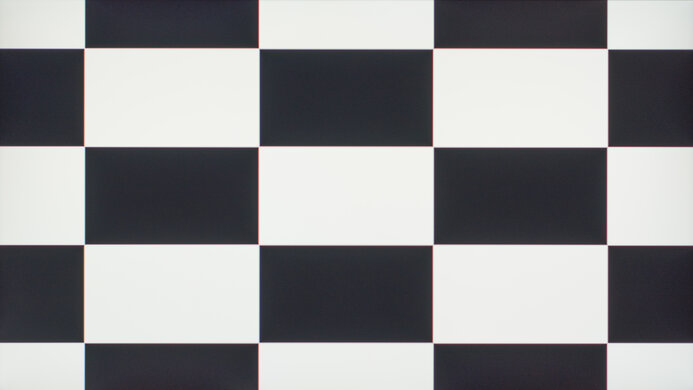- 75.0%Native Contrast
- 25.0%Contrast With Local Dimming
The contrast ratio is the ratio between the luminance of the brightest white and the darkest black that a monitor can produce. Higher contrast ratios typically mean deeper blacks, which makes a big difference in overall picture quality. It’s of particular importance for dark scenes in movies and games, especially in a dark room.
To test contrast, we measure the luminance of both white and black using a checkerboard pattern and then calculate the ratio between the two. Luminance is a metric used to measure the amount of light (or intensity) present on a surface and is expressed in cd/m², or candelas per square meter. This is commonly referred to as "nits".
Test results
When It Matters
 745 : 1 (LG 27GP83B-B)
745 : 1 (LG 27GP83B-B) 4365 : 1 (Dell S3222DGM)
4365 : 1 (Dell S3222DGM)Contrast is one of the most important aspects of picture quality, especially with modern HDR displays. Images tend to look better on displays with a high contrast ratio, as blacks are really black, and whites are really white. It's mainly noticeable in a dark room, especially when watching videos or playing games. It can also be noticeable on a PC if you choose to use a dark mode.
In a bright room, a higher contrast ratio isn't as important, as the reflected light in the room reduces the importance of deeper blacks, so higher contrast ratios aren't as beneficial.
Even in a dark room, small differences in contrast usually aren't very noticeable. Generally, a contrast ratio difference of 500 is considered a noticeable difference, but above a certain point, even this won't be very noticeable.
Our Tests
LCDs use liquid crystals to control the flow of light. Similar to how the shutter on a camera allows light into the sensor, the LCD allows light from the backlight to shine through to the colored filters. The problem is, no LCD technology is perfect, and some light always bleeds through.
When measuring the contrast ratio, we want to measure the amount of light that gets through when a pixel is in the "off" state. Our contrast tests are done after calibration, with the backlight set to output at about 100 cd/m², on average. We still measure the white luminance just to get the exact value, as it's usually impossible to calibrate them to exactly 100 cd/m².
Once we've measured the black and the white luminance, we're able to calculate the contrast ratio. To get this number, we divide the white luminance by the black luminance.
Because it's a ratio, there is no unit for contrast. Instead, contrast is normally expressed as ‘X : 1,’ with ‘X’ being how many times brighter white is than black. For example, a 5000 : 1 contrast ratio would mean that the television emits white that's five thousand times brighter than its black. The higher the contrast ratio, the deeper the blacks and the better the picture will look.
Although we take these measurements with the backlight set to 100 nits, there's usually very little change in the contrast ratio of a display as you adjust the backlight. The more light the backlight emits, the more light passes through the pixels, causing the black levels to increase roughly linearly with the white levels.
Native Contrast
The 'Native Contrast' ratio of a display represents the most basic contrast performance of the display, with all image processing and contrast-enhancing features turned off. To measure the native contrast ratio, we use a black and white checkerboard pattern to determine the black and white luminance, as described above. We calibrate the monitor to have a white luminance as close as possible to 100 cd/m², and then we take five luminance measurements using a Konica Minolta LS-100 Luminance Meter.
The white luminance, which should be close to 100 cd/m², is measured in the center white square. For the black luminance, we measure the luminance of each of the four black squares surrounding the white center square. This is to reduce the impact of black uniformity on our contrast measurement. The final black luminance number used in our calculation is the average of these four squares. Once we have both these values, the contrast ratio is simply the white luminance divided by the black luminance.
We don't list the actual black level that we measured during testing, but because we measure contrast after calibration, it's easy to work backward. If you want to know the approximate black levels we measured, assume that the white luminance was at 100 cd/m², and divide that by the contrast ratio. For example, a monitor with a contrast ratio of 5000:1 has an approximate black level of 0.02 cd/m².
Contrast With Local Dimming
The 'Contrast with Local Dimming' test is nearly identical to the 'Native Contrast' test, but this time, we measure the contrast ratio with the monitor's local dimming feature enabled. On monitors with multiple local dimming settings, we use the setting we recommend based on the results of our 'Local Dimming' test. In most cases, this is the highest setting available.
Most monitors don't have a local dimming feature, so for most of our reviews, this is set to 'N/A'. Local dimming on monitors is expected to become more and more common, especially as HDR displays grow in popularity.
Since we only measure the SDR contrast ratio, it isn't possible to measure the contrast ratio with local dimming on some monitors, as local dimming is only available in HDR. This is pretty rare, though.
How To Get The Best Results
As a first step, try using the calibration settings we recommend (provided we have reviewed your monitor). This will get good, basic contrast - meaning no additional contrast-enhancing settings - and with no loss of detail in dark portions of the image. You can find this information in the 'Post Calibration' section of the review.
Related Settings
- Contrast: Adjusting this will let you affect how much contrast the monitor has. We list a recommended setting with all of our reviews, but it's almost always fine to just set this to the maximum. On rare occasions, gamma might be affected, leading to a loss of detail in highlights.
- Local Dimming: The local dimming feature dims the backlight behind darker portions of the screen. It can deepen contrast, and it's worth using when implemented well. It can introduce issues like light blooming off of light objects within dark areas, and when done especially poorly, can dim the entire image. We discuss local dimming in more detail here.
- Full/Limited RGB: Full RGB may offer slightly more detail in blacks and shadows, but it’s not a big difference compared with limited RGB. Just make sure that both your monitor and your source device use matching RGB settings.
- Gamma: Gamma doesn't control the depth of black, but it does control the amount of detail you will see in dark portions of an image. If you find it difficult to make out detail in dark images, consider making a slight adjustment to the gamma.
Other Notes
- Backlight settings have a very minor impact on contrast, and so you should set it to whatever looks best in your viewing space. With LED Monitors, both white and black will become about equally brighter or dimmer when the backlight is adjusted, preserving the ratio of light to dark. With OLED monitors, adjusting the OLED light only increases the peak brightness; blacks are still perfectly black.
Native Contrast vs. Contrast With Local Dimming
One frequently asked question is which is more important, a panel's native contrast or contrast with local dimming? It's a good question. The answer is a bit complicated, but basically, it depends. Unlike TVs, most monitors don't have a local dimming feature. The few that do, generally speaking, don't work very well. They usually have very small zone counts, and the algorithms can't keep up with fast-paced motion, so the leading edge of a bright object in a dark scene ends up looking darker than the rest, and there's a trail of light behind it.
Because of these issues with local dimming, it's almost always more important to look at the native capabilities of a monitor instead of the contrast ratio with local dimming. Because most monitors have poor local dimming features, there's usually not that much of a difference between the native contrast of the panel and the contrast with local dimming when tested with a checkerboard pattern. In fact, of the 23 monitors with local dimming that we've tested on our latest test bench, only 4 of them can improve contrast by 10% or more with our test pattern through local dimming.
Differences In Measurement Techniques
There are different ways to measure contrast. We measure contrast with a checkerboard pattern and take the average black level from four squares, but some other review sites measure it differently, which can lead to a difference in posted numbers. Some of the other methods we've seen websites use include:
- Full On/Off: Some websites measure the contrast using a full white screen, and a full black screen. This is generally considered a less accurate way to measure contrast, and it isn't very realistic. Contrast measurements with local dimming tend to appear much better with this measurement technique, as it's easy for any monitor with local dimming to turn the entire screen off at once.
- Half Screen Slides: Similar to the above method, but one slide is shown with half of the screen black and half of the screen white. It's a bit better than the above method but still not very realistic.
- Small Samples: Similar to the full-screen method, but instead of large slides, contrast is measured using small slides that only cover part of the screen. This method isn't ideal either, as imperfect uniformity can significantly skew the results.
- ANSI Checkerboard: The most generally accepted way to measure contrast; a checkerboard pattern very similar to ours is used, but with an asymmetric test pattern. The ANSI method measures the output in all 16 squares and averages the values for the white and black squares. It usually produces very similar results to our own.
Because of differences in measurement techniques, equipment used, and even differences between units, it's extremely common for different websites to report different contrast measurements.
Differences In Display Technologies
Monitors use different display technologies, each with advantages and disadvantages. Knowing which type of panel is used in your monitor can already give you a good indication of what to expect in terms of contrast ratio:
- VA: These panels typically have the best contrast ratios. Typical contrast: > 2500
- IPS: Monitors with IPS panels have lower contrast ratios than VA monitors. Typical contrast: 700 - 1500
- TN: On average, TN monitors have the worst contrast ratios. Typical contrast: 600 - 1200
- OLED: OLED monitors essentially have perfect contrast, as each pixel is self-emissive, the black level of black pixels is essentially zero.
Even within the same panel types, it's normal for the contrast to vary a bit between units, even of the same model, due to manufacturing tolerances. Manufacturers used to provide the typical contrast ratio for each monitor, but recently, some brands, including LG, have started listing the minimum contrast ratio you could get. For IPS and TN panels, this difference usually isn't very significant, and most people shouldn't worry about it, but for VA panels, the variance between individual units and measurement techniques can be significant. For example, the LG 32GN600-B is advertised to have a typical contrast ratio of 3000:1, but according to LG, it could be as low as 1800:1 for some units. We measured a contrast ratio of 3248:1, almost double the minimum contrast for that model.
Conclusion
A monitor’s contrast ratio indicates the depth of blacks – a higher contrast ratio means deeper blacks – and, by extension, better picture quality. It’s a very important part of picture quality, so if you want something that looks good (particularly in a dark room), be sure to get a monitor that has good contrast.
There are a few things that can be done to improve contrast, but there are limits. As a good first step, look to our recommended picture settings (listed with every review), as those can help you get a good baseline. From there, you can enable or disable a few different settings that might help deepen blacks. Just remember that some of those settings will have other consequences on picture quality.


